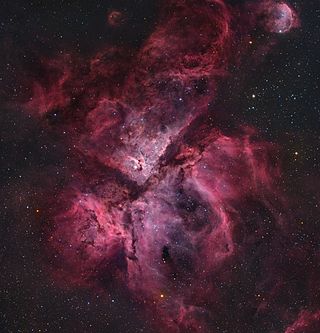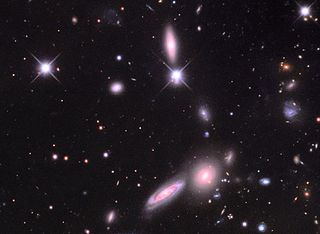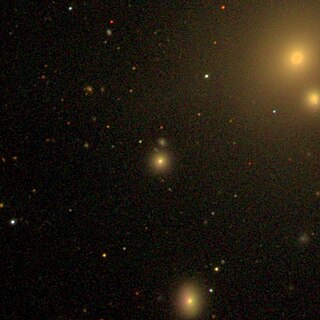
The Carina Nebula or Eta Carinae Nebula is a large, complex area of bright and dark nebulosity in the constellation Carina, located in the Carina–Sagittarius Arm of the Milky Way galaxy. The nebula is approximately 8,500 light-years (2,600 pc) from Earth.
NGC 358 is a very small open cluster of four stars in the constellation of Cassiopeia. It was originally thought to be an unrelated asterism, but two of the members were found to have a similar distance of roughly 1700 light years, although the other two do not have well-constrained distances, so its exact nature is uncertain.

NGC 85 is an interacting spiral or lenticular galaxy estimated to be about 200 million light-years away in the constellation of Andromeda. It was discovered by Ralph Copeland in 1873 and its apparent magnitude is 15.7. The galaxy appears to be interacting with the companion spiral IC 1546.

NGC102 is a lenticular galaxy estimated to be about 330 million light-years away in the constellation of Cetus. It was discovered by Francis Leavenworth in 1886 and its apparent magnitude is 14.

NGC 105 is a spiral galaxy estimated to be about 240 million light-years away in the constellation of Pisces. It was discovered by Édouard Stephan in 1884 and its apparent magnitude is 14.1.

NGC 6293 is a globular cluster located in the constellation Ophiuchus. Its Shapley–Sawyer Concentration Class is IV. It was discovered by the American astronomer Lewis A. Swift on 8 July 1885. Like many other globular clusters, its distance is not well known; it may be anywhere from 31000 to 52000 light-years away from Earth.

NGC 387 is an elliptical galaxy located in the constellation Pisces. It was discovered on December 10, 1873 by Lawrence Parsons. It was described by Dreyer as "very faint, small, round." Along with galaxies NGC 375, NGC 379, NGC 382, NGC 383, NGC 384, NGC 385, NGC 386 and NGC 388, NGC 387 forms a galaxy cluster called Arp 331.

NGC 1869 is an open cluster in the Dorado constellation. It is located within the Large Magellanic Cloud. It was discovered by James Dunlop on September 24, 1826, using a telescope reflector with a nine-inch aperture. It is a large cluster of rich scattered stars. It is part of a triple association with NGC 1871 and NGC 1873. It has an apparent magnitude of 14.0.

NGC 7047 is an intermediate spiral galaxy located about 270 million light-years away in the constellation of Aquarius. NGC 7047 is also classified as a LINER-type galaxy. NGC 7047 has an estimated diameter of 127,350 light years. It was discovered by French astronomer Édouard Stephan on August 20, 1873. In 2009 a supernova was found in NGC 7047.

NGC 1871 is an open cluster associated with an emission nebula located in the Dorado constellation within the Large Magellanic Cloud. It was discovered by James Dunlop on November 5, 1826. Its apparent magnitude is 10.21, and its size is 2.0 arc minutes.

NGC 1936 is an emission nebula which is part of the larger LMC-N44 nebula located in the Dorado constellation in the Large Magellanic Cloud. It was discovered by John Herschel in 1834 and added to the Catalogue of Nebulae and Clusters of Stars as NGC 1936. It was later observed by John Dunlop on September 27, 1936 and Williamina Fleming in 1901 and added to the Index Catalogue as IC 2127. Its apparent magnitude is 11.60.

NGC 1929 is an open cluster associated with the emission nebula located within the N44 nebula in the Dorado constellation and part of the Large Magellanic Cloud. It was discovered by James Dunlop on August 3 1826. Its apparent magnitude is 14.0, and its size is 0.8 arc minutes.

NGC 1934 is an emission nebula located in the Dorado constellation and part of the Large Magellanic Cloud. It was discovered by John Herschel on November 23 1834. Its apparent magnitude is 10.50.

NGC 2002 is an open cluster located in the Dorado constellation and is part of the Large Magellanic Cloud. It was discovered by James Dunlop on September 24, 1826. Its apparent magnitude is 10.1, and its size is 2.0 arc minutes.

NGC 1987 is an open cluster or a globular cluster located in the Mensa constellation and part of the Large Magellanic Cloud. It was discovered by John Herschel on November 3, 1834. Its apparent magnitude is 12.1, and its size is 1.7 arc minutes. It is thought to be around 600 million years old and has a significant number of red ageing stars.

NGC 6670 is a pair of interacting galaxies within the Draco constellation, which lie around 401 million light-years from Earth. Its shape resembles a leaping dolphin. NGC 6670 was discovered by Lewis A. Swift on July 31, 1886. NGC 6670 is a combination of two colliding disc galaxies which are known as NGC 6670E and NGC 6670W. The galaxy is 100 billion times brighter than the Sun. The galaxies have already collided once before and they are now moving towards each other again nearing a second collision. Its apparent magnitude is 14.3, its size is 1.0 arc minutes.

NGC 1998 is a lenticular galaxy located in the Pictor constellation. It was discovered by John Herschel on December 28, 1834 and is about 207 million light-years from the Milky Way. Its apparent magnitude is 14.3. and its size is 0.90 by 0.5 arc minutes. In some sources such as SIMBAD, it is misidentified as nearby double star NGC 1995.

NGC 527, also occasionally referred to as PGC 5128 or PGC 5141, is a lenticular galaxy located approximately 259 million light-years from the Solar System in the constellation Sculptor. It was discovered on 1 September 1834 by astronomer John Herschel.

















